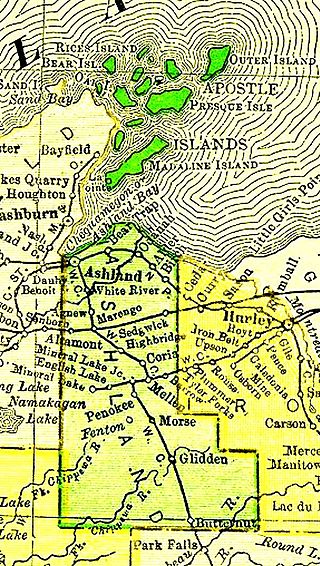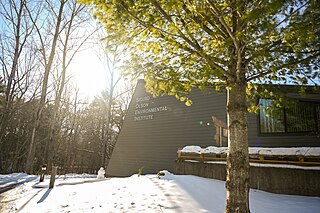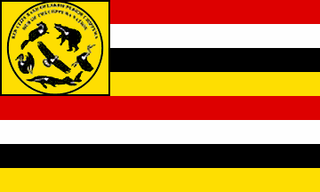
Bayfield County is a county located in the U.S. state of Wisconsin. As of the 2020 census, its population is 16,220. Its county seat is Washburn. The county was created in 1845 and organized in 1850. The Red Cliff Band of Lake Superior Chippewa has a reservation in Bayfield County and is the county's largest employer.

The Ojibwe, Ojibwa, Chippewa, or Saulteaux are an Anishinaabe people in what is currently southern Canada, the northern Midwestern United States, and Northern Plains. They are Indigenous peoples of the Subarctic and Northeastern Woodlands.

Bayfield is a city in Bayfield County, Wisconsin, United States. The population was 584 at the 2020 census. This makes it the city with the smallest population in Wisconsin. In fact, for a new city to be incorporated today, state regulations require a population of at least 1,000 residents, so it would have to be incorporated as a village instead.

The Apostle Islands are a group of 22 islands in Lake Superior, off the Bayfield Peninsula in northern Wisconsin. The majority of the islands are located in Ashland County—only Sand, York, Eagle, and Raspberry Islands are located in Bayfield County. All the islands except for Madeline Island are part of the Apostle Islands National Lakeshore. The islands in Ashland County are all in the Town of La Pointe, except for Long Island, which is in the Town of Sanborn, while those in Bayfield County are in the Towns of Russell and Bayfield.

The Bad River LaPointe Band of the Lake Superior Tribe of Chippewa Indians or Bad River Tribe for short are a federally recognized tribe of Ojibwe people. The tribe had 6,945 members as of 2010. The Bad River Reservation is located on the south shore of Lake Superior and has a land area of about 193.11 square miles (500.15 km2) in northern Wisconsin, straddling Ashland and Iron counties. Odanah, the administrative and cultural center, is located five miles (8.0 km) east of the town of Ashland on U.S. Highway 2. The reservation population was 1,545 in 2020. Most of the reservation is managed as undeveloped forest and wetland, providing a habitat for wild rice and other natural resources.

The Sigurd Olson Environmental Institute is an outreach arm of Northland College in Ashland, Wisconsin. The institute originated in 1971 at an environmental conference at Northland that hosted Sigurd Olson as a speaker. Robert Matteson was the founder of the Institute. The Institute opened in Spring, 1972.

The Raspberry Island Lighthouse is a lighthouse located on the southern part of Raspberry Island, marking the west channel of the Apostle Islands in Lake Superior in Bayfield County, Wisconsin, near the city of Bayfield. It was erected in 1862, marking the western channel.

Chequamegon Bay is an inlet of Lake Superior in Ashland and Bayfield counties in the extreme northern part of Wisconsin.

Red Cliff Band of Lake Superior Chippewa is a band of Ojibwe Native Americans. The Red Cliff Band is located on the Red Cliff Indian Reservation, on Lake Superior in Bayfield County, Wisconsin. Red Cliff, Wisconsin, is the administrative center. Red Cliff is notable for being the band closest to the spiritual center of the Ojibwe nation, Madeline Island. As of November 2010, there were 5,312 enrolled members, with about half living on the reservation and the rest living in the city of Bayfield or the Belanger Settlement.

Madeline Island Museum is a museum owned and operated by the Wisconsin Historical Society. Opened on June 15, 1958, the museum is in the town of La Pointe, Wisconsin on Madeline Island, one of the Apostle Islands in Lake Superior. Madeline Island Museum was developed on the former site of the American Fur Company Northern Outfit, and its main building once served as an American Fur Company warehouse. The museum can be reached by boat or by the Madeline Island Ferry.

Madeline Island is an island in Lake Superior. Located in Ashland County, Wisconsin, it has long been a spiritual center of the Lake Superior Chippewa. Although the largest of the Apostle Islands, it is not included in the Apostle Islands National Lakeshore. It is the only island in the Apostle Island chain open to commercial development and private ownership.

Chief Buffalo was a major Ojibwa leader, born at La Pointe in Lake Superior's Apostle Islands, in what is now northern Wisconsin, USA.
The Lake Superior Chippewa are a large number of Ojibwe (Anishinaabe) bands living around Lake Superior; this territory is considered part of northern Michigan, Wisconsin, and Minnesota in the United States. They migrated into the area by the seventeenth century, encroaching on the Eastern Dakota people who had historically occupied the area. The Ojibwe defeated the Eastern Dakota, who migrated west into the Great Plains after the final battle in 1745. While they share a common culture including the Anishinaabe language, this highly decentralized group of Ojibwe includes at least twelve independent bands in the region.
The Tragedy of the Siskiwit was an event that took place in the pre-contact history of the Ojibwe and Meskwaki (Fox) Indian nations in present-day Wisconsin. As part of an ongoing series of conflicts between the two nations, a chief's son was kidnapped, and both groups had their camps destroyed.
The Battle of the Brule was an October 1842 battle between the La Pointe Band of Ojibwe Indians and a war party of Lakota Indians. The battle took place along the Brule River in what is today northern Wisconsin and resulted in a decisive victory for the Ojibwe.
Michel Cadotte, Kechemeshane in Ojibwe was a Métis fur trader of Ojibwe and French-Canadian descent. He dominated the business in the area of the south shore of Lake Superior.

William Whipple Warren was a historian, interpreter, and legislator in the Minnesota Territory. The son of Lyman Marcus Warren, an American fur trader and Mary Cadotte, the Ojibwe-Metis daughter of fur trader Michel Cadotte, he was of Ojibwe and French descent. William lived in two cultures, because his father was white, he was not considered Ojibwe, but an Ojibwe "relative", because in the Ojibwe patrilineal culture, inheritance and property were passed through the paternal line. His mother was Ojibwe and he learned her culture from her family. He is the first historian of the Ojibwe people in the European tradition.

La Pointe is a town in Ashland County in the U.S. state of Wisconsin. The population was 428 at the 2020 census. The town includes all of the Apostle Islands except for the westernmost four, which lie in the towns of Bayfield and Russell in Bayfield County. The town includes the unincorporated community of La Pointe on Madeline Island, the largest of the Apostle Islands. The communities of Middleport and Old Fort are also located in the town. Its name in the Anishinaabe language is Mooningwanekaaning, meaning "The Home of the Golden Breasted Woodpecker".

La Pointe Indian Cemetery is the common name of the St. Joseph Mission Cemetery, located on Madeline Island in La Pointe, Wisconsin. It was added to the National Register of Historic Places in 1977. It is a frequently visited historical site.

Lucerne was a commercial schooner. In November 1886, she sank due to bad weather in Lake Superior, off Long Island in Chequamegon Bay. The site of the wreck was added to the National Register of Historic Places in 1991.

























